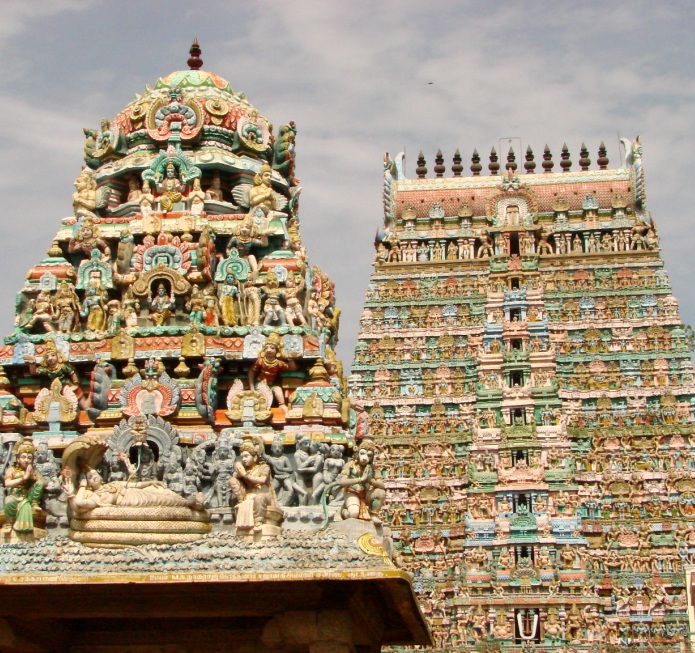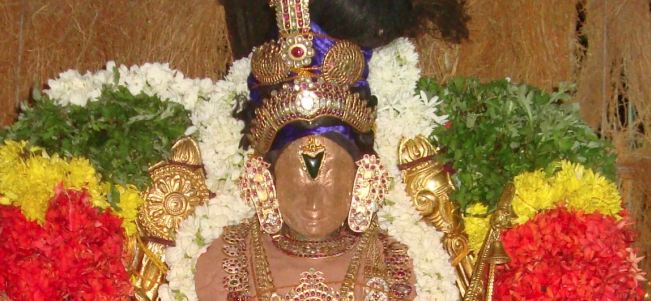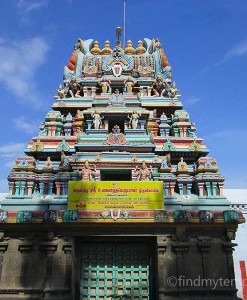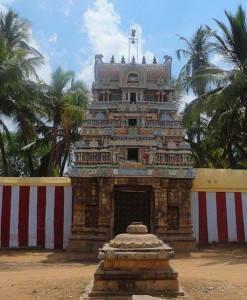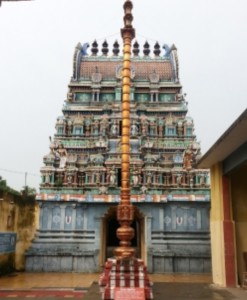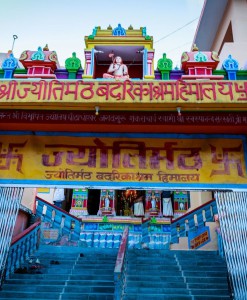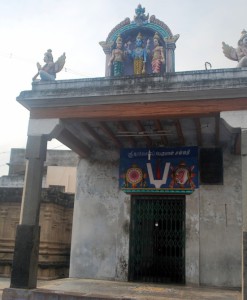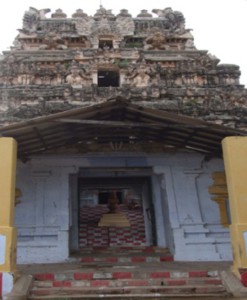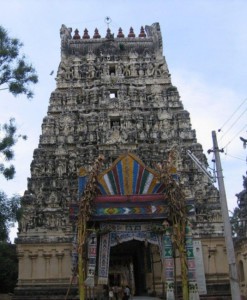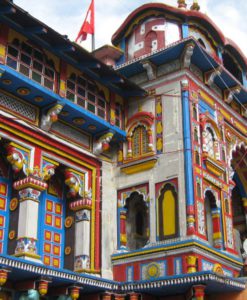No products in the cart.
Sri Sarangapanai Temple is a Vishnu temple located in the town of Kumbakonam in the Thanjavur district in Tamil Nadu. Located along the banks of the River Kaveri, this temple is one of the Pancharanga Kshetrams (a group of temples dedicated to Vishnu on the banks of the Kaveri) and is considered third in line to the Srirangam and Tirupathi temples in prominence. The Sri Sarangapanai Temple also gains special mention as one of 108 Divya Desams or the temples that are special to God Vishnu. The Sri Sarangapanai Temple has a significant presence in the Nalayira Divya Prabandham sung by the 12 Alwar poets.
Sri Sarangapani Temple,Kumbakonam,Tamil Nadu
Sri Sarangapanai Temple is the largest Vishnu temple in Kumbakonam and has the tallest temple tower in the town. The temple is enshrined within a huge wall and the complex enshrines all the water bodies of the temple except the Potramarai tank. The rajagopuram (the main gateway) has eleven tiers and has a height of 173 ft (53 m). There are five other smaller gopurams in the temple. The rajagopuram has figures depicting various religious stories. The temple faces east and the Potramarai tank is located outside the western entrance. The central shrine of the temple is in the form of a chariot drawn by horses and elephants, with openings on either side, showing the descent of Sarangapani from heaven in the chariot. There is a sculptural representation of the sage Hemarishi in the western part of the temple.
The central shrine of the temple houses the image of Sarangapani in pallikonda posture, with his head resting on his right hand. There are other images of sage Hemarishi, Lakshmi and festival images enshrined within the sanctum. There are two stepped entrances to the sanctum named as Utharayana Vaasal and Dhakshanayana Vaasal, each open for a six-month period. From 15 January to 15 July, Utharayanya Vaasal is opened while Dhakshanaya Vaasal is opened during the other half of the year. The Potramarai tank has a central hall called Hemarishi Mandapam. The temple has two processional chariots carved out of wood stationed outside the rajagopuram.
The temple is believed to be of significant antiquity with contributions at different times from Medieval Cholas, Vijayanagar Empire and Madurai Nayaks.
Sri Sarangapanai Temple is the center of many legends some of which we shall discover below.
The origins of the town of Kumbakonam itself are said to be divine nature. When Shiva decided to wipe the face of the earth clean and start life anew he decided to do so by the force of nature. He called upon a Pralaya Kaalam, a period of heavy rain to cleanse the earth. Brahma in order to secure the Vedas and the Amirtham which were essential for recreating life on earth created a mud pot and left it for safekeeping on top of the Mountain Meru. However the force of nature did not spare the pot and was washed away in the flood. The pot moved in a southerly direction and came to rest in a spot. After the floods subsided, the devas pleaded with Shiva to release the Amirtham so that life can begin. Shiva obliged and broke open the pot with an arrow from heaven. The Amirtham flowed from the pot and formed two pools of water which is what we now know as Maha maga kulam and the Potramarai kulam. The pieces of the pot combined with the Amirtham from which rose the form of Lord Kumbeswarar. The place of this divine event is now what is now known as Kumbakonam.
Another legend concerns Sage Brighu. An argument arose among the rishis as to whom they would submit an Avirbagam (an offering). Unable to decide the rishis sent Brighu Maharishi to tour each of the trinities’ respective abodes and declare a worthy winner. Brighu Maharishi made the trip to both Shivaloka and Brahmaloka but was treated with disdain and disrespect. Angered, he made his way to Vishnuloka hoping that he would be treated much more respectfully. Unfortunately Vishnuloka was no better and this angered Brighu to no end. In a fit of rage the maharishi, raised his foot and kicked the almighty Vishnu in his chest! Vishnu’s consort, Mahalakshmi who resided in his chest was angered by this act and retaliated. She left Vishnu’s abode and went to earth. Vishnu meanwhile responded to Brighu’s act of anger in a calm and collected manner. He held the sage’s legs and while trying to soothe his aching legs artfully plucked out the Brighu’s third eye (or Pride Eye) from under his toe! Brighu Maharishi regained his composure and realized the gravity of his actions. He pleaded to Mahavishnu to forgive him for his reckless deed.
Mahavishnu missed Mahalakshmi and went in search of her in the earth. He search high and low but his search was in vain. Dejected, Vishnu undertook the form of God Srinivasa and decided to marry Goddess Padmavati. He even borrowed money from God Kubera for his marriage as he could not afford it due to Lakshmi’s absence. But the marriage would not last long. Padmavati quarreled with Srinivasa and left Tirupathi for good. The news of Vishnu’s marriage to Padmavati and its eventual demise reached Mahalakshmi who was residing at Kollapuri through Naratha. This further angered her and she went in search of Vishnu to demand an explanation. Srinivasa anticipated Lakshmi’s anger and took refuge in a Paatha Loka (Abyss) in Kumbakonam to escape her wrath. Goddess Mahalakshmi’s search did not end successfully and hence she took the form of a small child named Bala Komalavalli and crawled the banks of the Potramaria Kulam.
A sage by the name of Hema Maharishi who was passing by saw Komalavalli and adopted her as his own. Hema Maharishi was none other than Sage Brighu Maharishi who sought retribution for his needless act of anger. He had taken the form of Hema Marishi and came down to earth, immersing himself in deep penance and praying that Lakshmi be born to him as a child. Sage Hema, raised Komalavalli up to her marrying age upon which he prayed to Mahavishnu to accept Lakshmi back as his consort. Mahavishnu acquiesced and descended upon the earth in a mighty chariot and married Komalavalli Thayar. The legend says that Vishnu’s chariot was the very temple which stands today at Kumbakonam and was also the very place where the wedding took place.
But Komalavalli Tayar was still angry at Vishnu’s act. In order to appease her Vishnu abandoned his mighty standing posture and took a more relaxed laying down pose. Further Vishnu took a Sarangam, in the name of Rama, a vow to stay true to Mahalakshmi and not marrying anyone else. And hence he came to be known as Sarangapani. Mahalakshmi also realized her errors and vowed to stay with Vishnu forever. Hence she came to be known as the ‘Padi Thaanda Pathini’.
The temple also plays a prominent role in the history of the Nalayira Divya Prabandham. The Divya Prabandhams were considered as a prominent holy text for the Vaishnavas. They were referred to as the Tamil Vedas and numbered over four thousand. Originally sung by the 12 Alwars, over time these slowly faded in prominence and were lost in time.
One day a devotee named Nadhamunigal while immersed in prayer at the Thirukkudanthai temple heard a hymn so enchanting and was completely overcome by them. Enquiring the two devotees who sang the hymn he came to know that they were part of a larger collection of thousand or so Paasurams. Nadhamunigal was determined to find the rest of the hymns and set out to the Saarangapani temple in Kudanthai as he remembered that the lyrics began with the words “Aara Amudhe”. Nadhamunigal immersed himself in prayer and in a flash of thought recollected the last line of the Paasuram. From this he identified that the Paasuram was written by Sadagopan of Thirukovilur and set out to Thirukovilur.
There he came across Madhurakavi Azhwar, a devotee of Nammalvar. Madhurakavi Azhwar presented the Kanninum Siruthambu Paasuram sung by his guru Nammalvar. Nadamunigal made his way to the Alwar Thirunagari temple and began chanting Madhurakavi Azhwar’s Paasuram over 12,000 times without stopping. Sensing his devotion, Nammalvar appeared before the devotee and imparted to him the knowledge of all 4000 Divya Prabandham. An overjoyed Nadhamunigal returned to his native Kaatu Mannar kovil and divided the Prabantha Paasurams into a group of four each covering close to a thousand Paasurams. Hence the journey of the 4000 Diva Prabandham began at this temple.
Sri Sarangapanai Temple timings are 6 am to 12 noon and 4 pm to 8 pm
Akshaya Tritiyai – 12 Garuda Sevai Chaitra Brahma Utsavam celebrated during the Tamil month of Chittirai (April – May), Vasantotsavam during Vaikasi (May – June), Pavitrotsavam – Ekadasi Jyeshotsavam during Adi(July – August), Sri Jayanthi – Uriyadi Utsavam during Avani (August – September), Navaratri Utsavam – Saraswathi Puja – Vijayadasami during Purattasi (September – October), Deepavali – Shraddha of Sri Lakshmi Narayanaswami during Aippasi (October – November), Deepa Utsavam – Unjal Utsavam during Karthigai (November – December), Pakal Pattu – Ira Pattu Pongal Sankaramana Utsavam during Margazhi (December – January), Kanu Utsavam – Amavasya – Ratasaptami during Thai (January – February), Masi Magaham – Float Festival during Masi (February – March) and Brahmmotsavam – Tirukkalyanotsavam during Panguni (March – April) are the festivals celebrated in the temple.
Sri Sarangapanai Temple lies in the Tanjore district of Tamil Nadu. It’s about 1 1/2 kms away from Kumbakkonam railway station, which is on the chennai – Thanjore main line. Bus facility and staying facilities are ample.
Videos:

